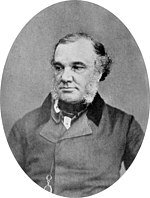Latest revision as of 20:38, 20 February 2024
バセドウ病はアイルランドの医師Robert James Gravesが1835年に外眼球腫を伴う甲状腺腫の症例を報告したことから名付けられた。ドイツ人のカール・アドルフ・フォン・バセドーも1840年に同じような症状を報告しており、イタリア人のジュゼッペ・フラジャーニは1802年に、アントニオ・ジュゼッペ・テスタは1810年に、イギリスの医師であるケイレブ・ヒリアー・パリー(エドワード・ジェンナーの友人)は18世紀後半にこの病気について発表している。トーマス・アジソンは1849年に初めてアジソン病を記述した。
 Thomas Addison
Thomas Addison
1902年、ウィリアム・ベイリスとアーネスト・スターリングは、十二指腸に酸を注入すると、膵臓が分泌を始めるという実験を行った。空腸粘膜のエキスを頸静脈に注入しても同じ反応が起こることから、粘膜の何らかの因子が原因であることがわかった。彼らはこの物質を「セクレチン」と名付け、このように作用する化学物質を「ホルモン」と呼んだ。
